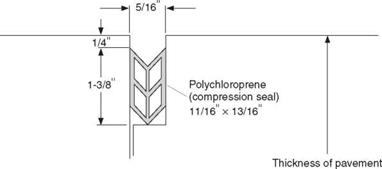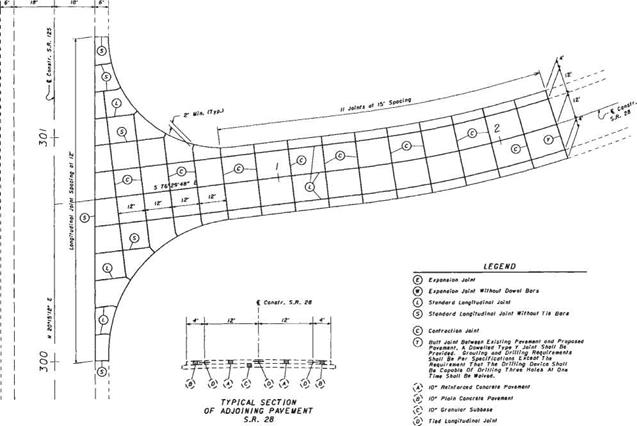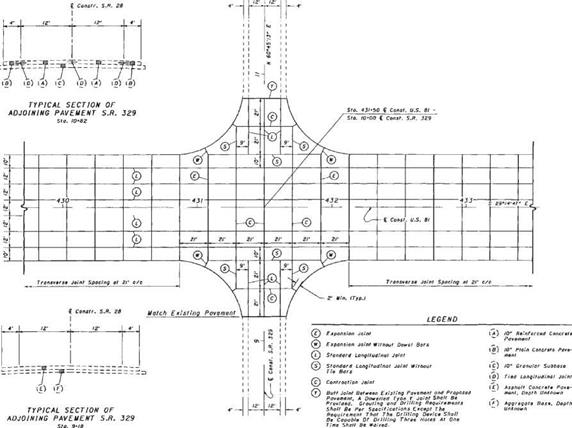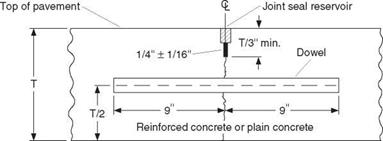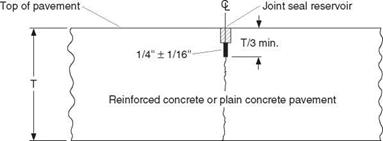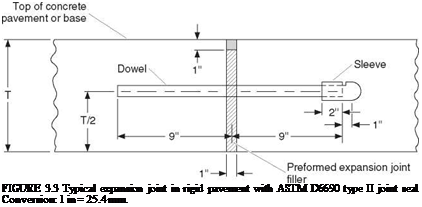Traffic Loading
Perhaps the most important step in designing a pavement is the estimation of the design traffic. Overestimation of the design traffic results in a thicker pavement than necessary with associated higher costs. Underestimation of traffic results in a thin pavement that will fail prematurely, resulting in higher maintenance and user costs. If the proposed pavement will be used to replace an existing pavement, the design traffic could be a projection of the existing traffic. If the proposed pavement is a new location, the design traffic will have to be estimated on the basis of the proposed use of the pavement. For design purposes, all traffic is equated to an equivalent 18-kip (80-kN) single-axle load, or ESAL. Each vehicle in the expected design traffic volume is converted to an ESAL by an equivalency factor. The equivalency factor is a function of the axle loading, pavement thickness, axle configuration, and terminal serviceability. As discussed in Art. 3.6, the terminal serviceability is an index of the serviceability of a pavement immediately before rehabilitation is needed.
The equivalency factors as given by the AASHTO Pavement Design Guide are presented here for flexible pavements in Tables 3.1 through 3.9, and for rigid pavements in Tables 3.10 through 3.18. For each pavement type, the tables are arranged by axle configuration and terminal serviceability pt. Factors are included for single-axle, tandem-axle, and triple-axle configurations, and for pt values of 2.0, 2.5, and 3.0. In the tables for flexible pavements, the pavement strength is characterized by a pavement structural number (SN), which is defined in Art. 3.7. The use of the tables is illustrated by the following example.
Consider a 30,000-lb (133-kN) transit bus that has a single front axle load of 10,000 lb (44 kN) and a tandem rear axle load of 20,000 lb (89 kN). Before the ESAL can be determined, the pavement thickness or structural number must be known, as well as the terminal serviceability. In an initial design, this necessitates assumptions, and very likely an iteration after the thickness or structural number has initially been determined. In this example, the ESAL is to be determined for a rigid pavement 7 in (178 mm) thick and for a flexible pavement with a pavement structural number of 4. The pt is taken as 2.5. The tables show that, for this case, the equivalency factor for rigid pavement is 0.089 for the front axle (Table 3.13) and 0.220 for the rear axle (Table 3.14). The equivalency factor for flexible pavement is 0.102 for the front axle (Table 3.4) and 0.141 for the rear axle (Table 3.5). Each bus equals 0.089 + 0.220 = 0.309 ESAL for rigid pavement and 0.102 + 0.141 = 0.243 ESAL for flexible pavement. A similar analysis would be completed for each vehicle type. A worksheet for making the calculations is provided in Table 3.19, and an example for using the worksheet is presented in Table 3.20.
The traffic supplied to the designer is usually the total traffic in both directions and all lanes. This traffic needs to be distributed by direction and lane to determine the required pavement thickness. The pavement is first divided by direction by multiplying by the directional factor. In most cases, this factor is equal to 0.5, assuming the loads are distributed equally in both directions. In some cases, the directional factor may be
|
TABLE 3.1 Axle Load Equivalency Factors for Flexible Pavements, Single Axles, and pt of 2.0
Source: Guide for Design of Pavement Structures, American Association of State Highway and Transportation Officials, Washington, D. C., 1993, with permission. |
greater than 0.5. An example would be an industry where material is hauled in by truck and shipped out by rail. In this case, loaded trucks would be going into the plant and empty trucks would be exiting the plant. The next factor is the lane distribution factor. As more lanes are added to a section of road, the traffic will be more distributed among these lanes. However, trucks tend to use the outermost lane, so the distribution of ESALs is not in proportion to the number of lanes added. Many of the state DOTs have developed lane distribution factors for use in pavement design. The AASHTO Pavement Design Guide presents a range of factors used for lane distribution as given below. It should be noted that for the same traffic, the thickness design will be greater for the pavement with the smaller number of lanes.
|
Number of lanes in both directions |
Percent of 18-kip (80-kN) ESAL traffic in design lane |
|
1 |
100 |
|
2 |
80-100 |
|
3 |
60-80 |
|
4 or more |
50-75 |
|
Axle load |
Pavement structural number (SN) |
||||||
|
kips |
kN |
1 |
2 |
3 |
4 |
5 |
6 |
|
2 |
9 |
0.0000 |
0.0000 |
0.0000 |
0.0000 |
0.0000 |
0.0000 |
|
4 |
18 |
0.0003 |
0.0003 |
0.0003 |
0.0002 |
0.0002 |
0.0002 |
|
6 |
27 |
0.001 |
0.001 |
0.001 |
0.001 |
0.001 |
0.001 |
|
8 |
36 |
0.003 |
0.003 |
0.003 |
0.003 |
0.003 |
0.002 |
|
10 |
44 |
0.007 |
0.008 |
0.008 |
0.007 |
0.006 |
0.006 |
|
12 |
53 |
0.013 |
0.016 |
0.016 |
0.014 |
0.013 |
0.012 |
|
14 |
62 |
0.024 |
0.029 |
0.029 |
0.026 |
0.024 |
0.023 |
|
16 |
71 |
0.041 |
0.048 |
0.050 |
0.046 |
0.042 |
0.040 |
|
18 |
80 |
0.066 |
0.077 |
0.081 |
0.075 |
0.069 |
0.066 |
|
20 |
89 |
0.103 |
0.117 |
0.124 |
0.117 |
0.109 |
0.105 |
|
22 |
98 |
0.156 |
0.171 |
0.183 |
0.174 |
0.164 |
0.158 |
|
24 |
107 |
0.227 |
0.244 |
0.260 |
0.252 |
0.239 |
0.231 |
|
26 |
116 |
0.322 |
0.340 |
0.360 |
0.353 |
0.338 |
0.329 |
|
28 |
125 |
0.447 |
0.465 |
0.487 |
0.481 |
0.466 |
0.455 |
|
30 |
133 |
0.607 |
0.623 |
0.646 |
0.643 |
0.627 |
0.617 |
|
32 |
142 |
0.810 |
0.823 |
0.843 |
0.842 |
0.829 |
0.819 |
|
34 |
151 |
1.06 |
1.07 |
1.08 |
1.08 |
1.08 |
1.07 |
|
36 |
160 |
1.38 |
1.38 |
1.38 |
1.38 |
1.38 |
1.38 |
|
38 |
169 |
1.76 |
1.75 |
1.73 |
1.72 |
1.73 |
1.74 |
|
40 |
178 |
2.22 |
2.19 |
2.15 |
2.13 |
2.16 |
2.18 |
|
42 |
187 |
2.77 |
2.73 |
2.64 |
2.62 |
2.66 |
2.70 |
|
44 |
196 |
3.42 |
3.36 |
3.23 |
3.18 |
3.24 |
3.31 |
|
46 |
205 |
4.20 |
4.11 |
3.92 |
3.83 |
3.91 |
4.02 |
|
48 |
214 |
5.10 |
4.98 |
4.72 |
4.58 |
4.68 |
4.83 |
|
50 |
222 |
6.15 |
5.99 |
5.64 |
5.44 |
5.56 |
5.77 |
|
52 |
231 |
7.37 |
7.16 |
6.71 |
6.43 |
6.56 |
6.83 |
|
54 |
240 |
8.77 |
8.51 |
7.93 |
7.55 |
7.69 |
8.03 |
|
56 |
249 |
10.4 |
10.1 |
9.3 |
8.8 |
9.0 |
9.4 |
|
58 |
258 |
12.2 |
11.8 |
10.9 |
10.3 |
10.4 |
10.9 |
|
60 |
267 |
14.3 |
13.8 |
12.7 |
11.9 |
12.0 |
12.6 |
|
62 |
276 |
16.6 |
16.0 |
14.7 |
13.7 |
13.8 |
14.5 |
|
64 |
285 |
19.3 |
18.6 |
17.0 |
15.8 |
15.8 |
16.6 |
|
66 |
294 |
22.2 |
21.4 |
19.6 |
18.0 |
18.0 |
18.9 |
|
68 |
302 |
25.5 |
24.6 |
22.4 |
20.6 |
20.5 |
21.5 |
|
70 |
311 |
29.2 |
28.1 |
25.6 |
23.4 |
23.2 |
24.3 |
|
72 |
320 |
33.3 |
32.0 |
29.1 |
26.5 |
26.2 |
27.4 |
|
74 |
329 |
37.8 |
36.4 |
33.0 |
30.0 |
29.4 |
30.8 |
|
76 |
338 |
42.8 |
41.2 |
37.3 |
33.8 |
33.1 |
34.5 |
|
78 |
347 |
48.4 |
46.5 |
42.0 |
38.0 |
37.0 |
38.6 |
|
80 |
356 |
54.4 |
52.3 |
47.2 |
42.5 |
41.3 |
43.0 |
|
82 |
365 |
61.1 |
58.7 |
52.9 |
47.6 |
46.0 |
47.8 |
|
84 |
374 |
68.4 |
65.7 |
59.2 |
53.0 |
51.2 |
53.0 |
|
86 |
383 |
76.3 |
73.3 |
66.0 |
59.0 |
56.8 |
58.6 |
|
88 |
391 |
85.0 |
81.6 |
73.4 |
65.5 |
62.8 |
64.7 |
|
90 |
400 |
94.4 |
90.6 |
81.5 |
72.6 |
69.4 |
71.3 |
|
TABLE 3.3 Axle Load Equivalency Factors for Flexible Pavements, Triple Axles, and pt of 2.0
|
|
Axle load |
Pavement structural number (SN) |
||||||
|
kips |
kN |
1 |
2 |
3 |
4 |
5 |
6 |
|
2 |
9 |
0.0004 |
0.0004 |
0.0003 |
0.0002 |
0.0002 |
0.0002 |
|
4 |
18 |
0.003 |
0.004 |
0.004 |
0.003 |
0.002 |
0.002 |
|
6 |
27 |
0.011 |
0.017 |
0.017 |
0.013 |
0.010 |
0.009 |
|
8 |
36 |
0.032 |
0.047 |
0.051 |
0.041 |
0.034 |
0.031 |
|
10 |
44 |
0.078 |
0.102 |
0.118 |
0.102 |
0.088 |
0.080 |
|
12 |
53 |
0.168 |
0.198 |
0.229 |
0.213 |
0.189 |
0.176 |
|
14 |
62 |
0.328 |
0.358 |
0.399 |
0.388 |
0.360 |
0.342 |
|
16 |
71 |
0.591 |
0.613 |
0.646 |
0.645 |
0.623 |
0.606 |
|
18 |
80 |
1.00 |
1.00 |
1.00 |
1.00 |
1.00 |
1.00 |
|
20 |
89 |
1.61 |
1.57 |
1.49 |
1.41 |
1.51 |
1.55 |
|
22 |
98 |
2.48 |
2.38 |
2.17 |
2.09 |
2.18 |
2.30 |
|
24 |
107 |
3.69 |
3.49 |
3.09 |
2.89 |
3.03 |
3.27 |
|
26 |
116 |
5.33 |
4.99 |
4.31 |
3.91 |
4.09 |
4.48 |
|
28 |
125 |
7.49 |
6.98 |
5.90 |
5.21 |
5.39 |
5.98 |
|
30 |
133 |
10.3 |
9.5 |
7.9 |
6.8 |
7.0 |
7.8 |
|
32 |
142 |
13.9 |
12.8 |
10.5 |
8.8 |
8.9 |
10.0 |
|
34 |
151 |
18.4 |
16.9 |
13.7 |
11.3 |
11.2 |
12.5 |
|
36 |
160 |
24.0 |
22.0 |
17.7 |
14.4 |
13.9 |
15.5 |
|
38 |
169 |
30.9 |
28.3 |
22.6 |
18.1 |
17.2 |
19.0 |
|
40 |
178 |
39.3 |
35.9 |
28.5 |
22.5 |
21.1 |
23.0 |
|
42 |
187 |
49.3 |
45.0 |
35.6 |
27.8 |
25.6 |
27.7 |
|
44 |
196 |
61.3 |
55.9 |
44.0 |
34.0 |
31.0 |
33.1 |
|
46 |
205 |
75.5 |
68.8 |
54.0 |
41.4 |
37.2 |
39.3 |
|
48 |
214 |
92.2 |
83.9 |
65.7 |
50.1 |
44.5 |
46.5 |
|
50 |
222 |
112. |
102. |
79. |
60. |
53. |
55. |
|
Source: Guide for Design of Pavement Structures, American Association of State Highway and Transportation Officials, Washington, D. C., 1993, with permission. |
Abbreviated procedures for determining ESALs have been developed by several states. These procedures usually involve grouping classifications of trucks into several categories and assigning an average equivalency factor to these categories. For example, Ohio groups trucks into two categories, single, or C units, and tractor-trailer, or B combinations. The average equivalency factors used by Ohio for these two categories are shown in Table 3.21.







